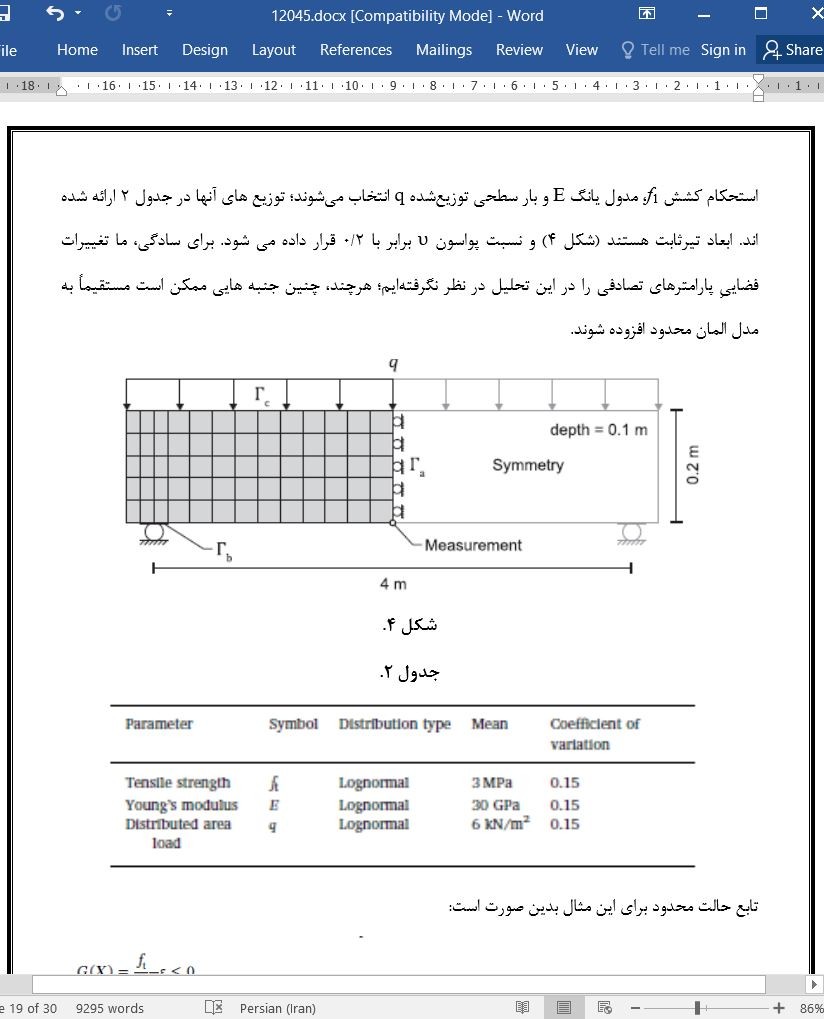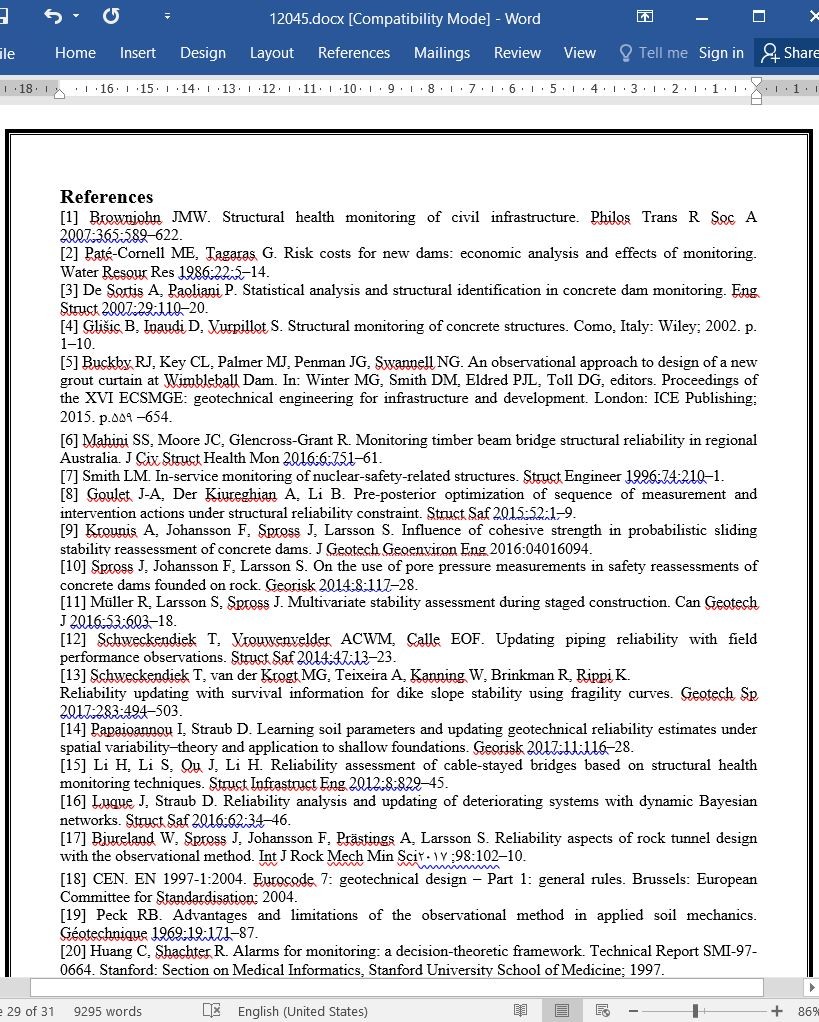
آستانه هشدار مبتنی بر قابلیت اطمینان برای سازه های تحلیل شده با روش المان محدود
چکیده
معمولاً سازه های مهندسی عمران نظارت می شوند تا رفتار ساختاری آنها، با استفاده از آستانه های هشدار مورد ارزیابی قرار داده شوند تا مشخص شود برای بهبود ایمنی آنها چه زمانی اقدامات احتمالی نیاز هستند. با این حال، در مورد چگونگی ایجاد آستانه هایی که ایمنی کافی را تضمین کنند دستورالعمل هایی نیاز است. بنابراین این مقاله یک الگوریتم محاسباتی کلی را برای ایجاد آستانه های هشدار مبتنی بر قابلیت اطمینان برای سازه های مهندسی عمران پیشنهاد می دهد. این الگوریتمبر اساس شبیه سازی زیرمجموعه با شبیه سازی زنجیره ی مارکوف مونت کارلوِجزء مستقل و قابل اجرا با هر دو مدل های ساختاریِ تحلیلی و مدل های المان محدود می باشد. آستانه های هشدارِ مبتنی بر قابلیت اطمینان می توانند مستقیماً در طرح های نظارتی که در مرحله ی طراحیِ یک پروژه ی ساخت توسعه یافته اند، به خصوص برای سازه هایی با بارگذاری متوالی مثل ساخت و سازهای مرحله ای خاکریزها، مورد استفاده قرار گیرند. با آستانه های هشدار مبتنی بر قابلیت اطمینان، اقدامات احتمالی تنها زمانی اجرا خواهند شد که رفع احتمالِ شکستِ هدف مدنظر باشد.
1. مقدمه
مشاهده ی رفتار سازه ای یک اقدام استاندارد در مهندسی عمران، به خصوص برای سازه هایی با اهمیت بالا یا ریسک بالا می باشد. از آنجایی که هزینه ی سنسورها و سایر تجهیزات کاهش می یابد، سازه های بیشتر و بیشتری تحت نظارت قرار می گیرند. نمونه هایی از این موارد عبارتند از سدهای بزرگ، پل ها، تاسیسات انرژی هسته ای، و سازه های ژئوتکنیک از جمله تونل ها و گودبرداری ها [1-7]. هدف می تواند شاملِ اعتبارسنجی فرضیات طراحی و ارزیابیِ نیاز به تغییرات طراحی یا اقدامات اصلاحی برای تضمین ایمنی ساختاری یا قابلیتِ استفاده ی رضایتبخش باشد. مشاهدات رفتار سازه ای همچنین می تواند برای کسب اطلاعات در مورد ویژگی های مهندسیِ سازه های موجود در ارزیابی های ایمنی ساختاری آنها مورد استفاده قرار گیرد. به طور کلی اطلاعات بیشترنشان می دهند که عدم قطعیت و ابهامات کاهش یافته و قابلیت اطمینان سازه ای محاسبه شده بهبود یافته است؛ به موجب آن، از اقدامات تقویتی یا جایگزین های پرهزینه نیز می تواند اجتناب شود. این اصل به طور گسترده در طراحی مبتنی بر قابلیت اطمینان و ارزیابی های ایمنی مبتنی بر قابلیت اطمینانِ زیرساخت های شهری بکار گرفته می شود، برای مثال به مراجع [8-17] مراجعه شود.
Abstract
Civil engineering structures are commonly monitored to assess their structural behaviour, using alarm thresholds to indicate when contingency actions are needed to improve safety. However, there is a need for guidelines on how to establish thresholds that ensure sufficient safety. This paper therefore proposes a general computational algorithm for establishment of reliability-based alarm thresholds for civil engineering structures. The algorithm is based on Subset simulation with independent-component Markov chain Monte Carlo simulation and applicable with both analytical structural models and finite element models. The reliability-based alarm thresholds can straightforwardly be used in the monitoring plans that are developed in the design phase of a construction project, in particular for sequentially loaded structures such as staged construction of embankments. With the reliability-based alarm thresholds, contingency actions will only be implemented when they are needed to satisfy the target probability of failure.
1. Introduction
Observation of structural behaviour is standard practice in civil engineering, in particular for structures of high importance or high risk. As the cost for sensors and other equipment reduces, more and more structures are being monitored. Examples include large dams, bridges, nuclear power facilities, and geotechnical structures such as tunnels and excavations [1–7]. The purpose can be, for example, validation of design assumptions and evaluation of need for design alterations or remedial measures to ensure structural safety or satisfactory serviceability. Observations of structural behaviour can also be used to gain information about engineering properties of existing structures in assessments of their structural safety. Additional information generally implies that uncertainties are reduced and that the calculated structural reliability is improved; thereby, costly replacement or strengthening interventions may be avoided. This principle is widely applied in reliability-based design and reliability-based safety assessments of civil infrastructure; see e.g. [8–17].
چکیده
1. مقدمه
2. هشدار (آلارم) چیست؟
3. آستانه های هشدار مبتنی بر قابلیت اطمینان
3.1. ارزیابی احتمال شکست
3.2. به روزرسانیِ احتمال شکست با اطلاعات اضافی
3.3. ایجاد آستانه های هشدار مبتنی بر احتمال شکست هدف
4. الگوریتم پیشنهادی
4.1. روش المان محدود برای مکانیک جامد
4.2. شبیه سازی زیرمجموعه
4.3. الگوریتم شبیه سازی برای ایجاد آستانه های هشدار
4.4. نظراتی در مورد این الگوریتم
5. مثال نمونه
5.1. توصیف و تشریح مورد: تغییرشکل یک تیرِ به سادگی تقویت شده
5.2. مدل تحلیلی
5.3. مدل المان محدود
5.4. ثابت های شبیه سازی
5.5. نتایج محاسبات
6. بحث
6.1. کاربرد عملی برای سازه های مهندسی عمران
6.2. اطلاعات نابرابری یا برابری؟
6.3. مفهوم احتمال شکستِ قابل قبول
7. نتیجه گیری
منابع
Abstract
1. Introduction
2. What is an alarm?
3. Reliability-based alarm thresholds
3.1. Assessment of failure probability
3.2. Updating of failure probability with additional information
3.3. Establishment of alarm thresholds based on target failure probability
4. Proposed algorithm
4.1. The finite element method for solid mechanics
4.2. Subset simulation
4.3. Simulation algorithm for establishment of alarm thresholds
4.4. Comments on the algorithm
5. Illustrative example
5.1. Case description: Deformation of a simply supported beam
5.2. Analytical model
5.3. Finite element model
5.4. Simulation constants
5.5. Calculation results
6. Discussion
6.1. Practical applicability to civil engineering structures
6.2. Inequality or equality information?
6.3. The concept of acceptable failure probability
7. Conclusions
Acknowledgements
References
- ترجمه فارسی مقاله با فرمت ورد (word) با قابلیت ویرایش، بدون آرم سایت ای ترجمه
- ترجمه فارسی مقاله با فرمت pdf، بدون آرم سایت ای ترجمه



